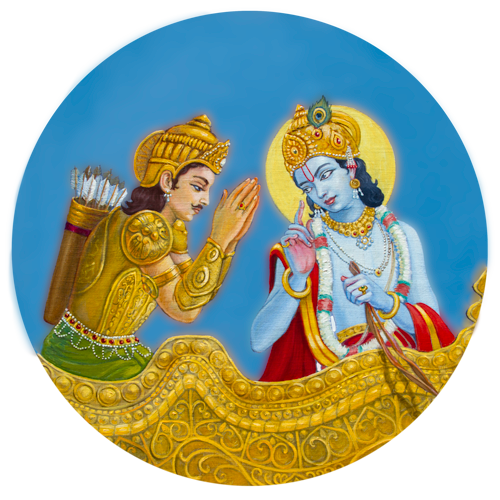The Bhagavad-gitā is the greatest spiritual text of Ancient India. It is a conversation between Lord Kṛṣna and His devotee, Arjuna, wherein Kṛṣṇa explains self-realisation, the nature of the ātmā (soul), reincarnation and other important topics.
Bhagavad-gītā means ‘the song of Bhagavān.’
Bhagavān refers to the Supreme Personality who possesses all divine opulences in full. In Sanskrit the word bhāga means ‘opulence’ and vān means ‘one who possesses’.
There are many persons who claim to be Bhagavān, but according to the Bhagavad-gītā, Kṛṣna is Bhagavān because He possesses all power, strength, fame, beauty, knowledge and detachment. You can read more in Bhagavad-gītā Chapter 2 – Sāṅkhya Yoga (The Yoga of Analysis) – Verse 8 and the Anuvṛtti
The Bhagavad-gītā is comprised of 700 verses, although it is originally part of a much larger book known as the Mahābhārata which is about 100,000 verses long – – seven times the size of Homer’s Illiad and fifteen times the size of the King James Bible.
Although the Bhagavad-gītā was written by Vyāsadeva, it should not be considered as a work of fiction. Mahābhārata is a history of ancient India which factually took place over 5000 years ago. Thus, Vyasadeva, who was present at the time, wrote down the events surrounding the Bhagavad-gītā. Read The History of the Bhagavad-gītā to find out more about the circumstances surrounding Gītā.
The Bhagavad-gītā was first spoken in approximately 3100 BCE (5,100 years ago). Read The History of the Bhagavad-gītā to find out more about the circumstances surrounding Gītā.
The backdrop of the Bhagavad-gītā is about two royal families, the Pāṇḍavas and the Kauravas. The Pāṇḍavas were followers of dharma (righteousness) whereas the Kauravas were opposed to dharma. This royal feud eventually led to a great war where the Bhagavad-gītā was spoken. For more information please see History of the Bhagavad-gītā.
The Gītā speaks about five subjects – the jīva (the individual unit of conciousness), īśvara (the Supreme Consciousness), kāla (the time factor), karma (action) and prākṛti (material nature).
Originally, the Bhagavad-gītā was spoken on the battlefield of Kurukṣetra (which is in the modern day state of Harayana, North India). Learn more about the circumstances and history surrounding Gītā in the article ‘The History of the Bhagavad-gītā’.
Bhagavad-gītā does not propagate any type of mundane ‘religion’. Bhagavad-gītā describes consciousness and super-consciousness and their connection with each other, as well as the relationship that we have with the world around us, the laws of karma, the nature of the self, life after death. Why the living entity suffers in this world and how to break the bondage of birth and death. This point is answered in detail in Bhagavad-gītā Chapter 3 – Karma Yoga (The Yoga of Action) – Verse 14 and Anuvṛtti
No – Bhagavad-gītā describes the Supreme Absolute Truth, or Super-Consciousness. ‘God’ is a nebulous word. The Bhagavad-gītā clearly describes the Super-Consciousness as a person, and not just an ill-defined, abstract principle.
Most religious books propagate particular dogmas and superstitions. They are devoid of any real philosophy and do not give a method for purifying oneself to advance spiritually. Bhagavad-gītā however is not based upon superstitions and gives a very clear explanation how an individual can spiritually progress in this world.
There are 700 verses divided into eighteen chapters in the Bhagavad-gītā.
There are many commentaries on the Gītā. In fact, all great ācāryas (spiritual teachers) in India such as Śaṅkara, Rāmānuja, Madhva, Vallabha, Baladeva Vidyābhūṣaṇa, Viśvanātha Cakravartī, Bhaktivinoda Ṭhākura, A.C. Bhaktivedanta Swami Prabhupāda and others have written commentaries. Swami Narasiṅgha has also written a concise and insightful commentary on Bhagavad-gītā to make the essence of Gītā accessible to the modern reader.
No. In the Gītā, Kṛṣna is very clear about bhakti (devotion to the Supreme) as the highest goal of human life. Some commentators however have created their own concocted philosophies and mutilated the words of Kṛṣṇa. Thus, we are told that one should only read the commentaries of those ācāryas who are in a genuine paramparā (disciplic succession) – in this way, the message of the Gītā is not changed or distorted.
Commentaries are necessary to show the real intent of the speaker, in this case Śrī Kṛṣṇa. If a famous person gives a lecture, some people in the audience may interpret (or misinterpret) what he has said. However, those who are close to the speaker and know him can repeat what he said and elaborate upon it, without changing the original meaning. Therefore, ācāryas of various philosophical schools have given their commentaries on the Gītā according to their understanding. It is not that one ācārya is wrong and another is right – they are just seeing Kṛṣṇa’s words from various angles of vision. There is no fault in this provided their vision is in accordance with their gurus, the previous teachers and the Vedic literature.
The commentaries written by Baladeva Vidyābhūṣana, Viśvanātha Cakravartī Ṭhākura, Bhaktivinoda Ṭhākura and A.C. Bhaktivedanta Swami Prabhupāda are all in the line of the Gauḍīya Vaiṣṇava school which follows the teachings of Śrī Caitanya Mahāprabhu. In additon to these, the commentary by Śrīla B.G. Narasiṅgha Mahārāja was written in a simple style in order to allow newcomers to the Bhagavad-gītā to have a clear understanding of the text. If one reads the commentary by Swami Narasiṅgha, one can then read the commentary of his guru, Śrīla A.C. Bhaktivedanta Swami Prabhupāda and have a deeper appreciation.
Of course! However, in discussing with new readers of the Gītā, many of them have said, “I took one look at the size of Prabhupāda’s Gītā, and I got scared!” Swami Narasiṅgha’s Gītā gives all the main points of the Gītā in a concise way and enourages us to then delve into the purports of Śrīla Prabhupāda.
No. Anyone can read the Gītā, no matter what his status.
Throughout the history of the world, mankind has dealt with the same problems – birth, death, old age and disease. Human beings had always asked the same questions – “Why am I here? Why is there suffering? What is the goal of life? etc” Even though the Bhagavad-gītā was spoken over 5000 years ago, these questions still remain pertinent in today’s modern world.
According to the Gītā, life in the material world is temporary. The four things that we experience here are birth, death, old age and disease. Any happiness we may experience here is impermanent and ultimately leads to more suffering. True happiness in life can only be achieved when one understands his natural position as ātmā and surrenders to Kṛṣṇa. Understand more about the cycle of birth, death, old age and disease in Bhagavad-gītā Chapter 13 – Prakṛti-Puruṣa Viveka Yoga (The Yoga of Differentiation) – Verses 8-12 and the Anuvṛtti
In the Gītā, Kṛṣṇa says that in this material world death is inevitable. Everyone who is born is sure to die according to their allotted karma, so ultimately there is no need to grieve. Read about life, death and re-birth in Bhagavad-gītā Chapter 2 – Sāṅkhya Yoga (The Yoga of Analysis) – Verses 13-15 and the Anuvṛtti
The Gītā recognises that violence and war are inevitable features of this material world. While the living entity continuously nurtures his lower instincts such as lust, anger, greed, envy etc. there will be no peace either individually or collectively. The Bhagavad-gītā is about controlling these mundane traits and cultivating our higher propensities in order to free ourselves from the bondage of saṁsāra. More can be found on this point in Bhagavad-gītā Chapter 2 – Sāṅkhya Yoga (The Yoga of Analysis)
The Bhagavad-gītā states that one should perform one’s duty. In the case of Arjuna, his duty as a kṣatriya (warrior) was to fight. Arjuna felt compassion for his enemies, and desired to abandon his duty as a kṣatriya. Kṛṣṇa however, explained to him that due to the immorality of the opposing side, Arjuna’s pity for them was misplaced and that their fate was already sealed. You can learn more about this in Bhagavad-gītā Chapter 2 – Sāṅkhya Yoga (The Yoga of Analysis)
The battle of Kurukṣetra was not about promoting one religion over another. Ultimately it was about establishing righteousness. The Pāṇḍavas were the legal heirs of the kingdom, and their cousins, the Kauravas, had usurped the throne. The Pāṇḍavas represented dharma (righteousness), whereas the Kauravas embodied adharma (impiety). You can read more about this in Bhagavad-gītā Chapter 1 – Sainya-Darśana (Observing the Armies on the Battlefield) – Verse 11 and the Anuvṛtti
No, the Gītā promotes varṇāśrama-dharma, a system which is a natural social hierarchy based upon one’s inherant inclinations. Later in Indian history, varṇāśrama-dharma was corrupted by ambitious persons and became degraded into what is known today as the ‘caste-system.’ This has created inequality, discrimination, exploitation, prejudice etc. You can learn more about varṇāśrama in Bhagavad-gītā Chapter 4 – Jñāna Yoga (The Yoga of Knowledge) – Verse 13-15
Kṛṣṇa clearly states in the Gītā that all actions in this world produce a reaction. Actions are defined as karma (pious actions according to Vedic injunctions), vikarma (impious actions contrary to Vedic injunctions) and akarma (those activities that do not produce any material result). Engaging in karma and vikarma forces the living being to remain in this material world, reincarnating in various species of life. Akarma refers to those actions that are dedicated to Kṛṣṇa – such devotional activities transcend all material reactions and bring one closer to the Supreme. You can read more about karma in Bhagavad-gītā Chapter 3 – Karma Yoga (The Yoga of Action) and Chapter 4 – Jñāna Yoga (The Yoga of Knowledge)
Read Articles and Books related to Bhagavad-gītā
- 📖 Bhagavad Gita – Swami B.G. Narasiṅgha Mahārāja’s Commentary (Book)
- 🎧 Bhagavad Gita Audiobook (Swami B.G. Narasingha Maharaja)
- ❔Bhagavad-gītā FAQs
- 📖 Bhagavad Gita As It Is – Original 1972 Macmillan Edition (Book)
- The Secret of the Lord’s Appearance According to the Gītā by Śrīla Bhaktivinoda Ṭhākura
- Introduction to the Bhagavad-gītā by Śrīla Śrīdhara Mahārāja
- The History of the Bhagavad-gītā by Swami B.V. Giri



